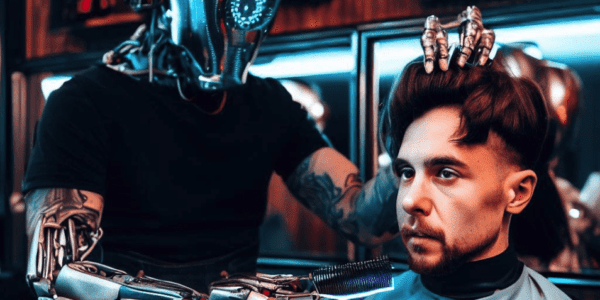You’re in a marketing meeting and someone makes a suggestion.
The idea (and your immediate reaction) sounds something like this.
“Let’s make an industry report.”
Waitaminute… Research reports are an effective format, but that’s not a plan.
“Let’s write blog posts about our services.”
Waitaminute… That’s just a topic. That’s not a plan.
“Let’s connect with that influencer.”
Waitaminute… That influencer has a great audience. But this isn’t a plan.
This is a common problem in content marketing. Ideas are everywhere, but strategic plans are in short supply. Most ideas are just a topic (“let’s write about x”) or a format (“let’s make videos”) or a channel (“let’s do Instagram”).
Really a great plan would combine all of these elements (topics, formats, promotion channels) and mix in a few more. There are at least six key aspects in the best content marketing plans. They fit nicely in a chart under three columns: creation, promotion and measurement.
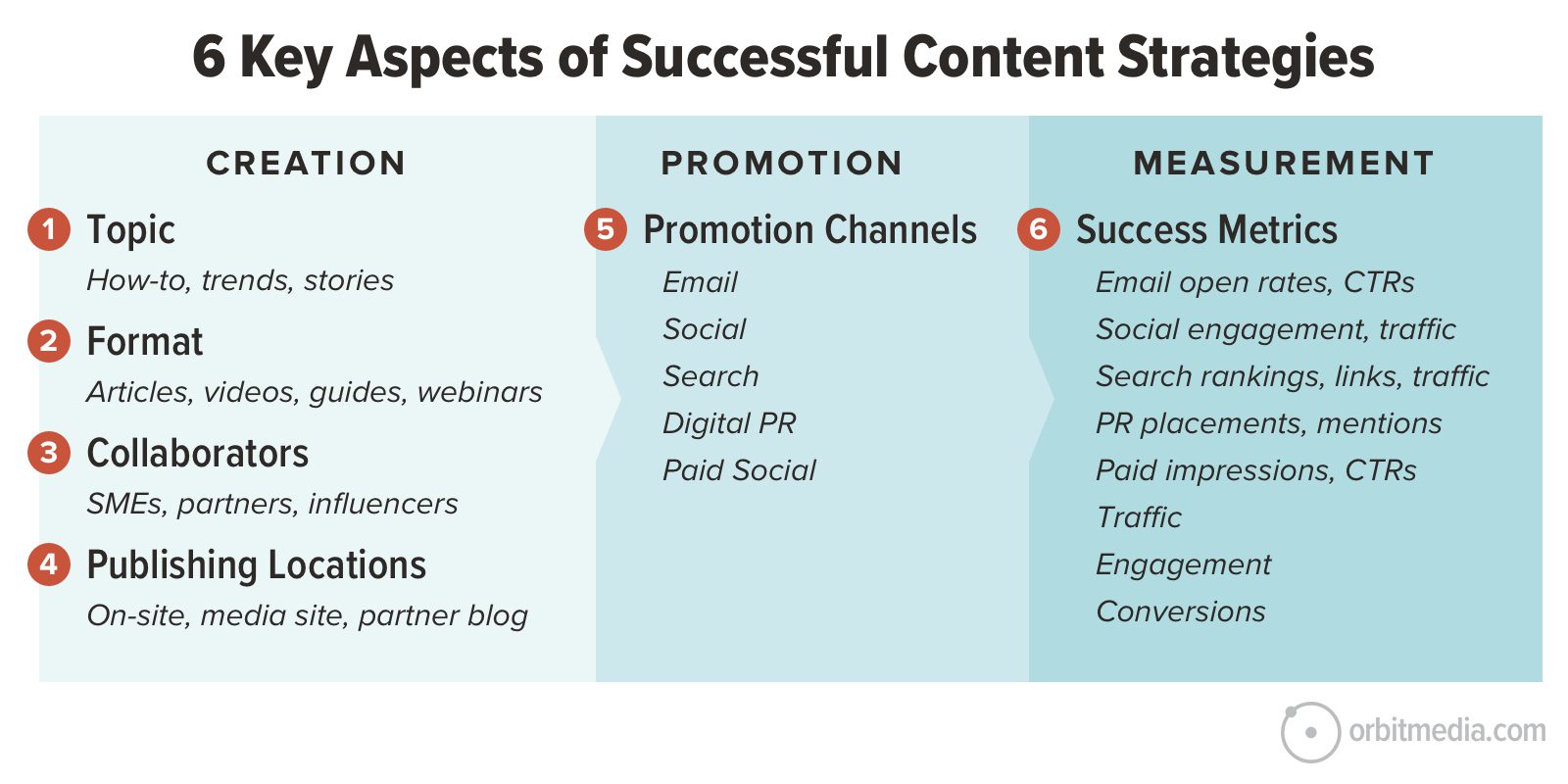
A content program that includes all six of these aspects is very likely to succeed. It’s comprehensive. It’s strategic.
Let’s look at each one more closely.
- Topic
What’s the subject of the content?
It’s useful and maybe entertaining. Usually, they know they need it (it answers questions). But sometimes it’s an unexpected insight or perspective (thought leadership). - Format
What form is it in?
Text, images, audio, video and events are basically all of the possible formats. More specific versions include guides, infographics, podcasts and webinars. - Collaborators
Who helps to create and promote this content?
Often this is an influencer that they already know and trust. Sometimes it’s a subject matter expert that adds depth and credibility. Occasionally, it’s a partner, prospect or editor that you’re networking with (that’s called zero-waste marketing) - Locations
Where will this appear?
Something will live on our site of course, but there are other options. Guest posts are published on partners’ websites. Some content is native on a platform (YouTube). - Promotion channels
How will it be discovered?
Social, search and email are the classic promotion channels. More specifically are the actual social networks, the search keywords, the link attraction plans, the email list growth plans and outreach ideas for digital PR. - Success metrics
How will we know it worked?
Some success metrics are channel-specific (email clickthrough rates, social engagement) and others are in your Analytics (traffic, conversions) All of them align directly or indirectly to the goals.
Just because an idea includes all six doesn’t mean it has to be super detailed. In fact, a quick content strategy can be summarized in a single sentence …maybe two.
So here are three very brief but comprehensive content strategies which go way deeper into those three shallow ideas listed above. Each is an example of how content marketing is about creative, collaborative ideas with few out-of-pocket expenses and many long-term benefits.
We’ll start each with a business and a few marketing goals. Sound fun? Ready? Here we go!
B2B Service Example: Cybersecurity Company
As a B2B service provider in a high-consideration category, trust is important. Our services aren’t cheap, so leads are potentially valuable. Some of our prospects need help urgently (we’ve been breeched!) so staying top of mind is critical.
So we have a few simple goals.
Goals:
- Increase awareness/trust among infosec professionals
- Grow authority (links) and eventually rank higher for infosec related phrases
Research reports can build trust, right? Someone read that in a blog post, so they suggested it in a meeting.
Not a plan:
“Let’s make an industry report”
A report is just a FORMAT for content, just like video or podcasts or case studies. It may be a very effective format for content and part of a great content strategy, but a format is not a plan.
Content marketing plan:
“Let’s survey 200+ experts about top trends in cybersecurity and…
interview the five most famous experts, then…
publish a detailed, visual industry report…
in collaboration with a cybersecurity association’s trade publication.
We’ll encourage partners/contributors to share and link to it…
Repackage as a video and presentation for live events and…
repeat the research annually.”
That’s a detailed content strategy (or at least a high-level description of a comprehensive content program) in just a few sentences. Let’s unpack it a bit more.
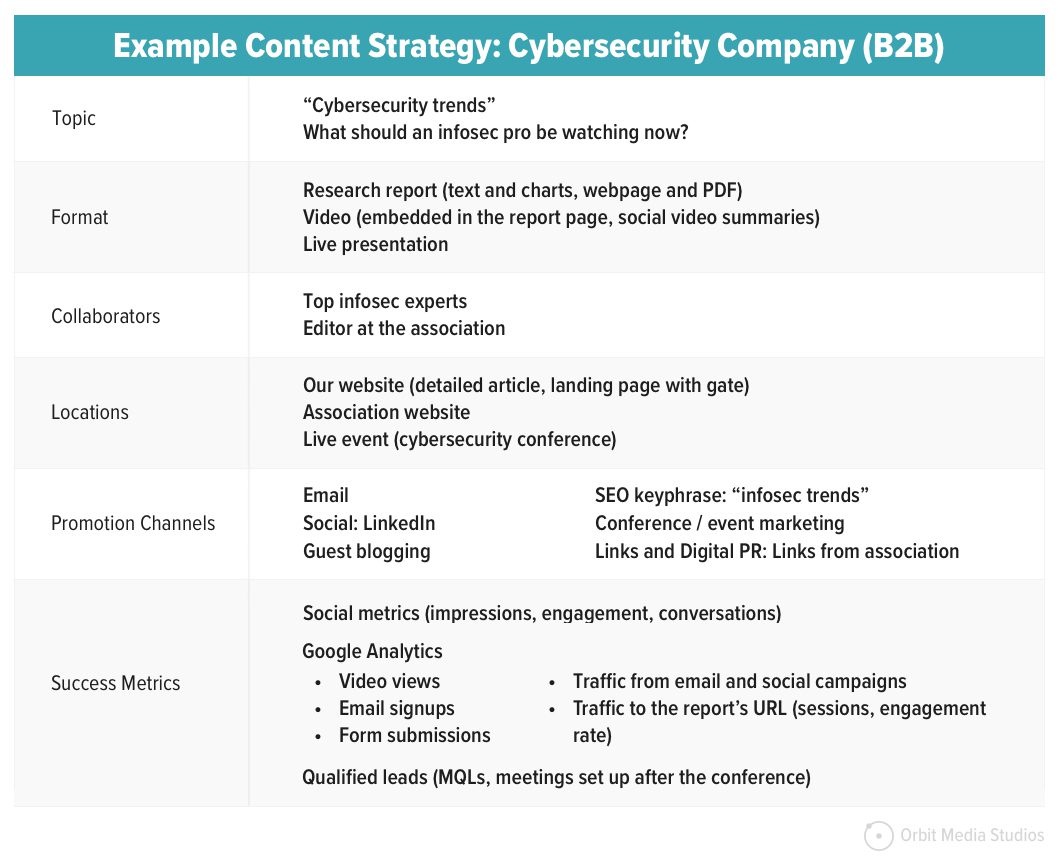
It started as just a format. But when we add the other five aspects, it suddenly becomes much more strategic. It now has promotion plans and influencer collaborations. More formats are included and a publishing partner has been added to the mix. Suddenly, it’s very likely to succeed.
Let’s highlight a few of the strengths of this plan:
- Research attracts links. Original research will make our website the primary source for new information, and publications will likely cite us. Those links will power our Domain Authority and, eventually, our rankings.
- Repeating it every year will make the data ever more valuable, and gathering responses gets easier as the email list grows. Annual research is the easiest research to promote.
- Influencer relationships will grow our reach quickly. And if we build long-term relationships with these influencers, more collaborations will come naturally. Maybe one of them would like to host a short webinar series.
- Speaking at events can drive demand. A few attendees may need our help right away. And having new research makes it easier to pitch to conferences. If our association partner has an event, our pitch might be a natural fit.
What if we support this with paid advertising?
A program like this could easily be supported with paid. This would add gas to the promotion engine. Imagine:
- LinkedIn ads could put the report in front of the right people.
- Paying the influencers would incentivize them to promote everything more heavily.
- Sponsoring the event would make your brand more visible at the conference.
B2C Service Example: Boat Maintenance Company
Our buyer wants to take good care of an inflatable boat. They like to do some things themselves, so publishing DIY tips for boat repair is an obvious fit. But if we can rank for the commercial-intent phrase we’ll drive a steady stream of qualified leads.
Goals:
- Rank higher for “inflatable boat repair”
- Grow email list with people (mostly professionals) who own these types of boats
Not a plan:
“Let’s write blog posts about boat storage”
It’s an idea but definitely not a plan. “Boat storage tips” is a TOPIC for a content program. It may have a great audience/topic fit. Our readers might really need this information. But a topic isn’t a plan. Let’s mix in the other five aspects and see what it looks like.
Content marketing plan:
“Let’s write a big inflatable boat storage guide on our site…
Then partner with a blog for fishing tour operators to write a 5-part series about boat maintenance…
Linking back to our own blog and our boat maintenance page and…
The final article will launch at the end of the boating season…
We’ll gather pics of boat storage problems from Facebook…
Then do light-hearted video interviews with a fishing/boating influencer about do’s and don’t’s of boat storage…
And then invite viewers to subscribe to get the boat maintenance guide.”
Now that’s much more of a plan. It includes the various formats for publishing, the promotion channels, the influencers and the timing.
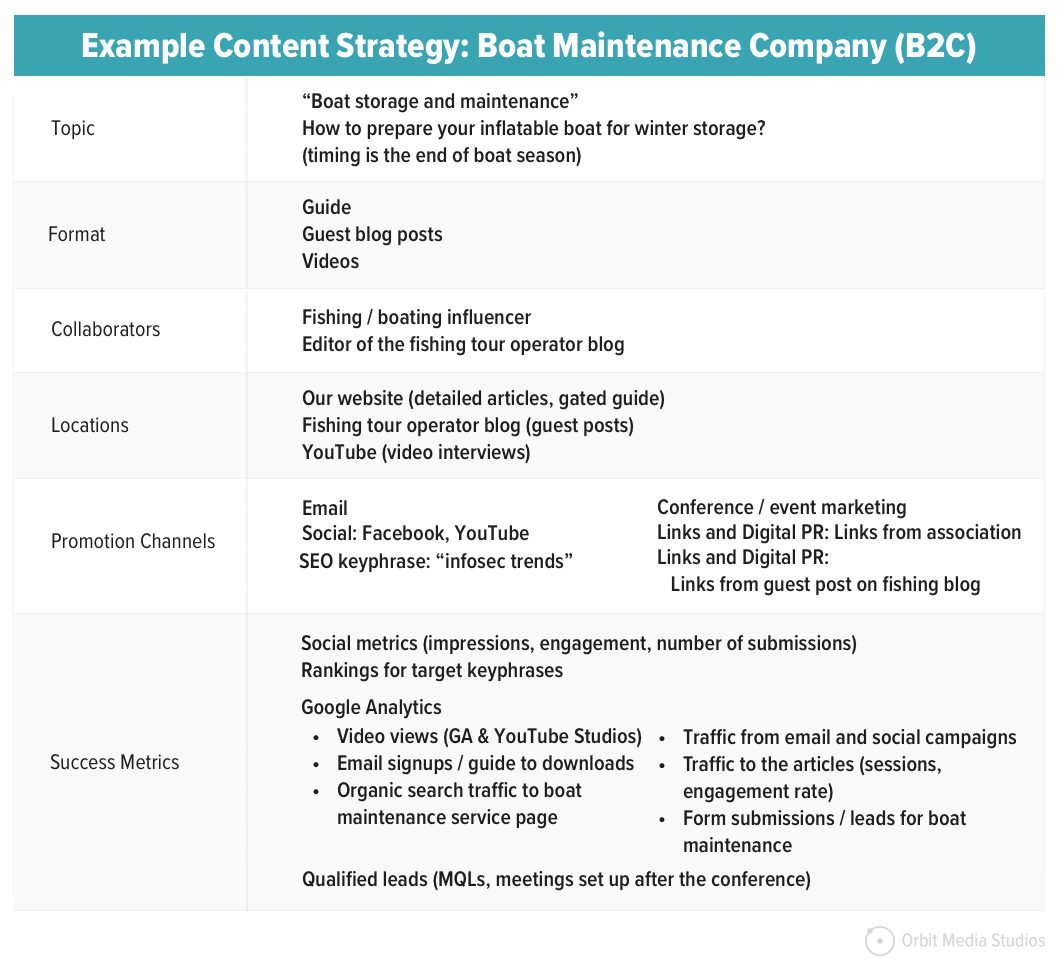
Clearly, when we build in the other key aspects of a good content marketing strategy, success is easy to imagine. Success seems inevitable!
Let’s highlight a few of the strengths of this plan:
- By adding a media partner, we’ll improve our reach immediately and our Domain Authority eventually.
- The timing aligns with seasonal demand. And we can re-promote the guide every year.
- Video is an excellent format for any DIY maintenance topics. They’ll be embedded into articles and separately optimized for search. Our “Inflatable Boat Tips” YouTube channel may eventually drive huge visibility.
- The visuals (how NOT to store a boat) will make a great hook on social media.
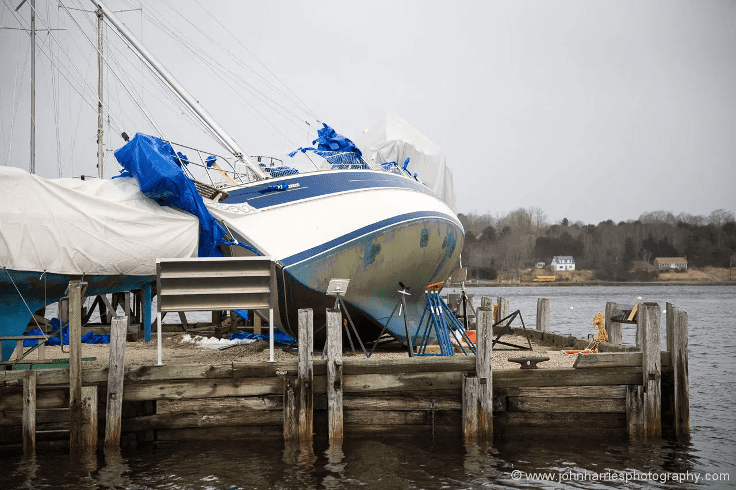
Non-Profit Example: Nature Museum
As a cultural and conservation institution, our audience cares deeply about the environment, but it’s tricky to keep their attention and get them interested in our seasonal programs. Social is great, but email is our best tool for keeping in touch with members and prospective members and donors.
Goals:
- Increase awareness for spring programs
- Grow the email list to support future fundraising efforts
Not a plan:
“Let’s connect with that influencer”
Influencer marketing may be effective and the right COLLABORATOR may win attention for the museum and your programs, but it’s just the sprout of an idea. It’s not a developed plan.
Content marketing plan:
“We are going to reach out to that well-known photographer…
and ask them to be the judge in a nature photo contest…
We’ll promote the contest on Instagram using a hashtag and…
gather submissions (and email addresses) on our website…
Visitors will vote for winners among the finalists selected by the judge, then…
We’ll announce the winner live on Facebook…
using a local news anchor as the host…
then ask if they’ll cover the story on their local TV news show.”
That feels much more strategic.
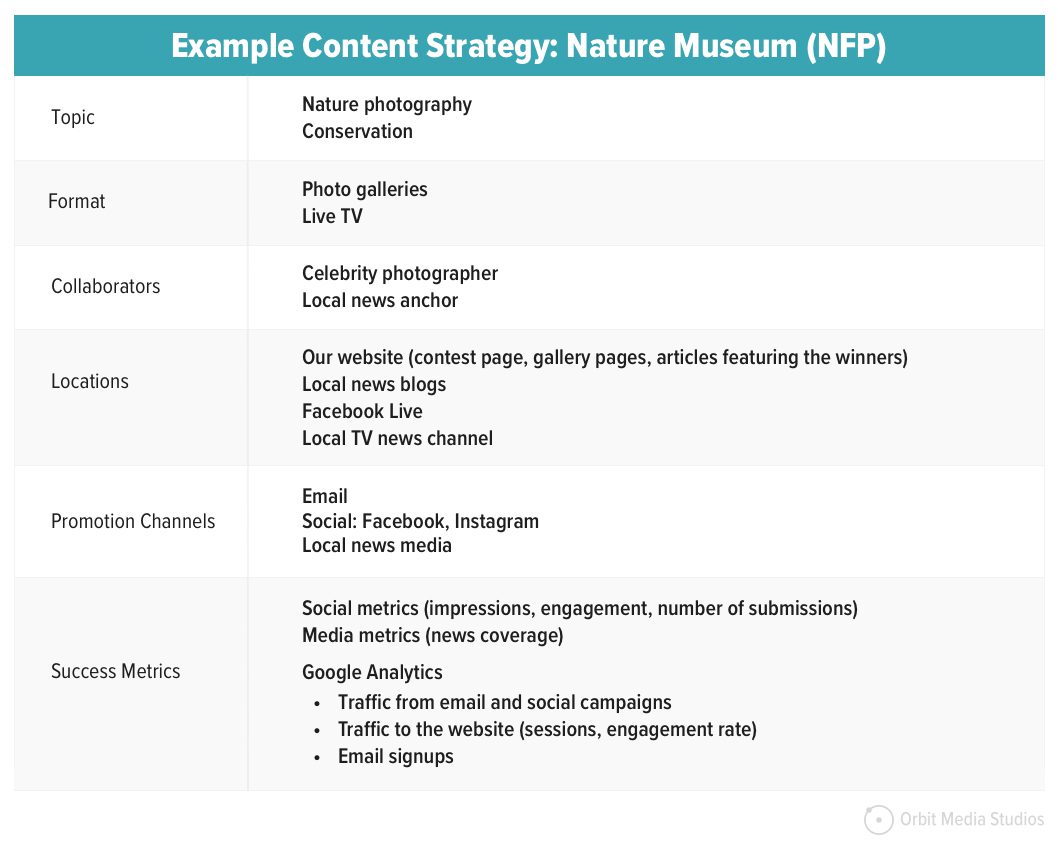
It’s visual and collaborative. It empowers our audience with user-generated content. And it’s focused on the local market, which fits our audience. And there could be multiple winners for various age groups or types of photos.
Let’s highlight a few of the strengths of this plan:
- There is an excellent local PR play that combines the name of the influencer, the visuals of photography and the virtuous cause of the museum. It’s likely to get picked up.
- It has live components and deadlines which give us the opportunity to use urgency.
- It has very strong social advantages: It’s visual, it involves an influencer and it’s based on user-generated content.
- Visitors will come for the contest and some will opt in for more, growing the email list.
And in the end, it will trigger awareness for the museum and for conservation, which is the ultimate mission.
 |
Michael Brenner, Marketing Insider Group“Your potential customers are searching for solutions to their biggest problems every single day. But the best strategies go beyond the keyphrase. Work with influencers and subject matter experts and you’ll improve both your reach and your credibility.” |
Expand the plan into an actionable strategy
Each of these examples was overly simplistic. But that was the idea. An actual plan would include several more aspects of content strategy that we skipped completely, including:
- Technology
What’s the platform for publishing (CMS), landing page testing, measurement, sending emails, automations? - Frequency
How often does this program repeat? How does it fit within the cadence of other programs and promotion? - Team and resources
Who will be involved in the creation, outreach, promotion and measurement? Who owns it? Do we need outside resources? A budget? - Process and workflow
How will the program be managed? What’s the most efficient process for production and promotion?
In the end, a strategy is just a plan to reach a goal. And a plan is an idea with more specifics. So once you add in those specifics and align everything with a goal, you basically have a content strategy.
Idea + Specifics + Goals = Content Strategy
Put it all together and you’re ready to turn on the machine.
Can you summarize your own content program in under a minute?
What if I met you at a conference? Could you give me a concise elevator pitch that covered those six aspects in a single description? If not your entire content strategy, what about one part of it?
Marketers need to sell their ideas in meetings with bosses and pitches to clients. Sometimes we need to sell the idea of content marketing or defend a marketing strategy when someone asks “Why should we blog?” Of course, the answer is “We aren’t just blogging. We are…”
That’s where you come in with an easily summarized content strategy.
That concise, strategic summary is a fantastic sales tool.
Bonus! While we’re celebrating brevity…
…here’s a summary of content strategy in 180 seconds. Enjoy!

